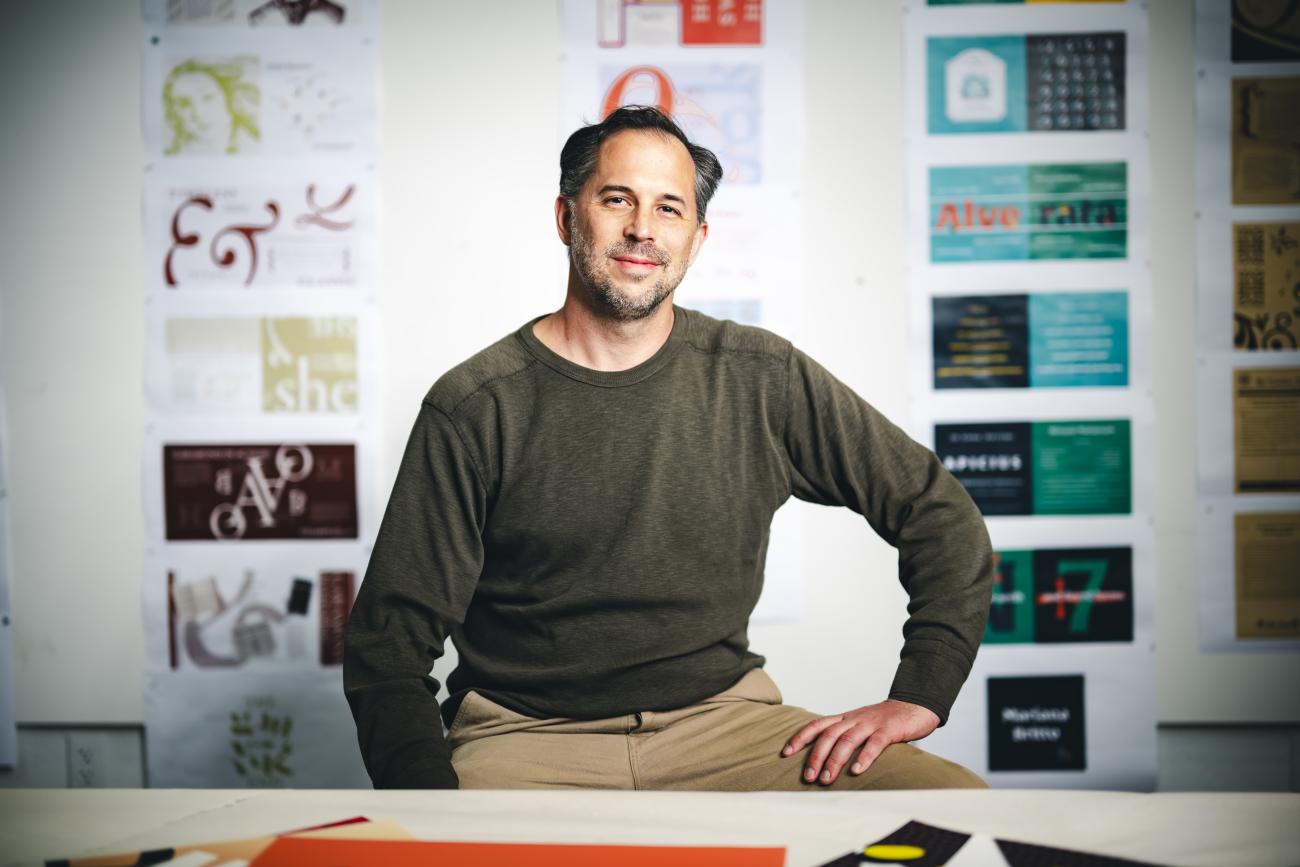Designing Understanding
Kevin Lahoda’s Research Lies at the Intersection of Culture, Technology, and Teaching
At the crossroads of cultural inquiry and technological exploration, Kevin Lahoda is charting a design practice that is as thoughtful as it is future-facing. A designer whose work is influenced by a background in anthropology, Lahoda’s scholarship interrogates what it means to do research in design and what it means to teach it.
Today, his research focuses on how graphic and interactive design can be used to make complex, often invisible systems visible and comprehensible. But the story doesn’t begin with pixels or posters.
“"For two decades, I worked professionally as an interactive designer and front-end developer, so I’ve experienced the evolution of the web firsthand.,” says Lahoda, assistant professor of design in the Department of Art, Architecture, and Design. “When we talk about data visualization, what interests me is how designers, whether through research or practice, are exploring alternative ways of turning data into stories. This might take the form of traditional graphic design or something less conventional. Ultimately, it's about stepping back from the final product to ask: What are we really trying to do with data?"
Data can be experiential—something from which people can learn, make connections, and find meaning—Lahoda says. He’s interested in using figures and numbers to support learning and connection-making. So, his research emphasizes the importance of data literacy and physicalization, the process of turning abstract information into physical, tangible objects or experiences, such as sculptures, installations, wearables, or interactive environments. The goal is often to make data more engaging, accessible, and meaningful by involving the body and senses, he says. By interacting with data in a physical space—touching it, walking around it, manipulating it—people can develop a deeper, often more intuitive understanding of the information.
Lahoda’s path to graphic design has a somewhat roundabout story. He was an anthropology major as an undergraduate student with a concentration in archaeology and social anthropology. He worked as a field archaeologist for a couple of years after college before deciding to make a career change.
“There's always been that piece, that cultural piece about technology that has been fascinating to me,” he says. “So, just going through my personal evolution it’s interesting to see how it’s paralleled the development of network technologies. As these tools have changed, so have we—both individually and as a society. The internet, in particular, has had a profound impact on how we operate and how we connect with one another.”
Lahoda’s students are immersed in his design ethos from day one. In an information design class, one student recently created a visual narrative charting the ecological cost of artificial intelligence—translating the abstract energy demands of AI into tangible metrics. ChatGPT “drinks” roughly a half liter of water for every 50 or so queries, so the student scaled the metaphor to bathtubs and Olympic-sized pools, transforming an invisible infrastructure into an evocative, data-driven story.
“Basically, the idea was back-of-the-napkin kind of math,” he says. “It's a little loose, but it's making a point. It's data-informed, this idea that anytime you put a prompt in for a ChatGPT, there is an cost connected. That student didn’t just learn about AI’s environmental impact by being told about it. They learned about it through the design process—by translating data into form and meaning.”
Lahoda’s emphasis on discovery, iteration, and critical thinking is woven into his teaching. He encourages students to dwell in uncertainty, explore ambiguity, and ask deeper questions before arriving at polished outcomes. There is often a rush in the industry to get to the deliverable, he says. But if you fast-forward through discovery, you miss the human insight. And that’s frustrating for students who want to go deep.
“It's great to see when students are engaging on that level of critical thinking and then cultivating some critical discourse around it. There's the potential of making that impact in different ways. It's been shown by research that if you ask somebody to read something, they're going to understand it a certain way. You try to show them a picture that says the same thing, and that's going to double up [their comprehension]. It's going to reinforce that learning. Multimodal engagement, which is something that we can do with interactive media, has a lot of potential for engagement. And then, ideally, going back around to the idea of design as an advocate for something, or getting people to do or think something different.”
Lahoda’s work also lives at the intersection of digital media and physical experience outside the classroom. One current professional project, developed in collaboration with ecologists and educators, explores how hybrid design tools can support ecological literacy in children. The setting? A bird banding station on Chesapeake Bay. There, Lahoda is co-developing an educational toolkit that merges interactive digital interfaces with sculptural objects. The goal is to help young learners grasp complex ideas about migration, climate, and conservation through tactile and visual exploration. This multimodal approach draws from both educational research and design theory, leveraging the power of visual and embodied learning. For Lahoda, it’s also about accessibility—crafting knowledge pathways that welcome diverse learners.
Similar principles guide his collaboration with Lehigh’s Small Cities Lab, where he contributes design strategies to support affordable housing advocacy. In these community-facing projects, design research becomes a mode of civic engagement. Graphic design can serve an important role in addressing these issues, he says.
“It's on the ground doing research out in the field,” he says. “Our approach is finding issues, teasing out the hidden processes might be to affect change and influence stakeholders, to bring partners in and get people to collaborate. And there's a lot of potential with graphic design to be in service to that. It’s a tool of advocacy and understanding.”

